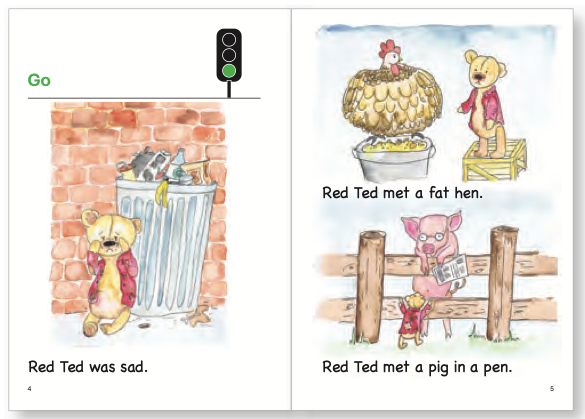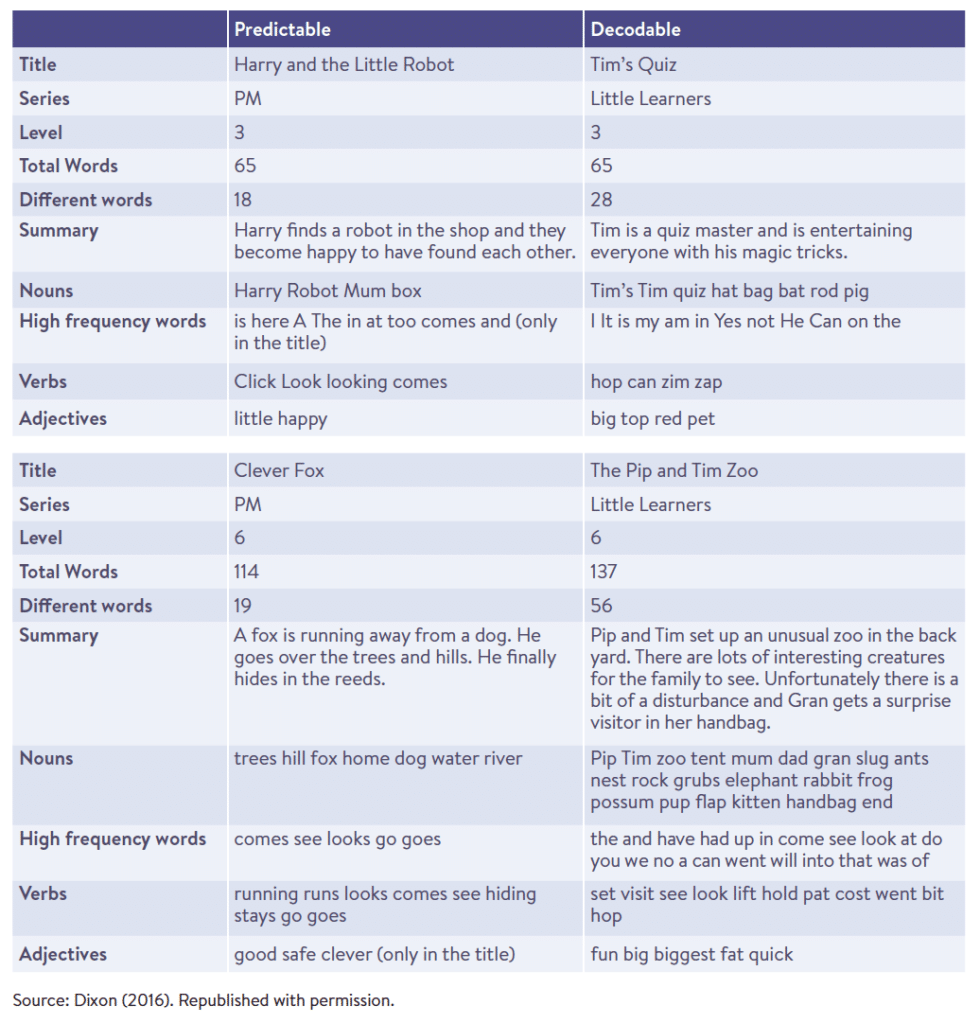What are decodable books and why are they important?
Decodable books are simple books that are written for the beginning reader and contain the specific grapheme-phoneme correspondences students have learned. This provides learners with the opportunity to use their developing segmenting and blending skills to read words in order to develop automaticity, or the ability to recognise words quickly and effortlessly, and experience independent reading success.
Decodable books encourage children to sound out words using phonic decoding strategies rather than guessing from pictures or predicting from other cues. They can be introduced once beginning readers have learned some simple grapheme-phoneme correspondences and can blend from left to right.
All books and text are ‘decodable’ in the sense that they can be read, but only if the reader has sufficient reading ability for the complexity of the text. For beginning readers, the only books that are truly decodable are those that contain the alphabetic code they have learned.
A sample page from the InitiaLit readers series: Red Ted.
The type of reading material we first give to students sets their ‘reading reflex’, the habit of using knowledge of letter-sound relationships as the first strategy for reading unfamiliar words. Decodable readers that enable students to ‘sound out,’ rather than guess, unknown words develop this reflex and lead to more successful independent reading. Mesmer (2005) found that children were more likely to apply their phonics knowledge, read more accurately, and needed less assistance when reading decodable books.
Of course, decodable texts are not the only texts to be included in the beginning reader’s diet. Teachers and parents should read high quality children’s literature that contains more complex vocabulary and sentence structures with students every day. This gives children the opportunity to hear good reading models, as well as develop the vocabulary and syntax that will support their reading development.
About decodable books
Decodable books are sequential in nature and build phonic knowledge gradually, allowing students the opportunity to practice grapheme-phoneme correspondences and quickly build their confidence and ability to read connected text. Decodable readers, unlike predictable or repetitive ‘levelled’ texts, minimise the inclusion of grapheme-phoneme correspondences or high frequency words children have not been taught. In comparison, levelled texts often rely on readability formulas that do not gauge the level of difficulty consistently (Begeny & Greene, 2013).
Speech and language pathologist Alison Clarke has created a video explanation of the problems with repetitive text and how they compare to decodable texts
Beginning decodable books contain words that are simple in structure such as VC and CVC words, and progressively introduce words with more complex structures. Providing children with opportunities to read successfully and relatively independently as soon as they can is highly motivating for beginning readers.
Some students will move through the sequence of decodable books quickly whereas other students, such as those who are at risk of reading difficulties, will take longer to develop automaticity and fluency with simple text. Once the alphabetic principle is secure and children have acquired a sufficient level of phonics to independently and successfully decode unfamiliar words, other books can be introduced for reading practice (Pogorzelski & Wheldall, 2018).
A presentation by Dr Tanya Serry of La Trobe University on the use of decodable, predictable and authentic texts in early reading instruction
Cheatham and Allor (2012) examined seven high-quality peer-reviewed studies and found decodability to be a “critical characteristic of early reading text as it increases the likelihood that students will use a decoding strategy and results in immediate benefits, particularly in regard to accuracy.” They also highlighted the need for students to apply phonics skills in connected text and found that decodable text positively impacts early reading progress.
Decodable books are sometimes criticised for having a limited vocabulary and simple storyline. This is sometimes true, as it is equally true of predictable or ‘levelled’ texts. However, comparisons of decodable and levelled texts reveal that decodable books can actually have more vocabulary variety (Dixon, 2016).
The purpose of decodable readers is to develop phonological decoding skills, and this is the focus of the text construction. As children master more of the alphabetic code and progress through a series of decodable books, the vocabulary and story structure become more sophisticated.
The simplicity of the text in decodable books has been found to be motivating for students, and to encourage them to read more widely. In a study by Capper (2013) children reported enjoying reading decodable books and saw them “as a source of exciting stories which developed their reading confidence through practising their skills”.
Decodable vs predictable text
Decodable texts are different to predictable or repetitive texts. Predictable texts are early readers that contain repetitive words and sentences. Predictable texts have their foundations in the three-cueing systems model of reading. The three-cueing model has significant disadvantages for weak or at risk readers.
Predictable texts have been designed so that beginning readers have to rely heavily on contextual guessing to read many of the words that are on the page. They contain more complex words with grapheme-phoneme correspondences that the students have not been taught.
The comparison of decodable and predictable/leveled texts below shows that although the decodable texts by design have a more limited range of GPCs, they have more variety in terms of number of different vocabulary items. It is clear from these examples that students who are learning simple VC and CVC words in the early stages of learning to read will not only have much more success with good decodable text but will also be exposed to more words. The narrative in the decodable text is arguably more engaging than the predictable text.
As can be seen from the example of a decodable text shown above, decodable books can be created to be appealing to young children even though the choice of words is necessarily restricted in the early stages of learning to read. If possible, children should read more than one decodable book a week (more than once) as this will expose them to a larger range of words.
Both decodable and predictable texts often contain a number of words that cannot be decoded easily at the early stages of reading, but are needed to be able to create meaningful sentences. Words such as said, was or the are often included and introduced to beginning readers to be learned as whole words or ‘sight words’. However, decodable books are careful to limit the number of these words so that children are not relying on guessing as their primary strategy.
Things to look for when selecting decodable books for use in your school’s reading program:
- The sequence of grapheme-phoneme correspondences through the series of books is clearly outlined and this must be matched to the scope and sequence implemented in phonics instruction in the school
- The target grapheme-phoneme correspondences should appear often throughout the text. Some poor quality decodable books have very few examples of the target GPC
- Text that is continuous and includes correct grammar and punctuation
- Early decodable readers should contain only one sentence to a page and then progress to more text as the readers gain more experience
- Any ‘tricky’ words are noted for teachers so they can be discussed with beginning readers prior to reading the text to minimise potential confusion
- Use of tricky words is minimised so that the primary strategy is decoding using phonic knowledge rather than guessing words in context
- Text is written in Standard English
How to get decodable books
MultiLit has a large range of decodable books designed for use with the InitiaLit program in Foundation and Year 1 but which can be used in any early reading classroom.
The NSW government has provided video and written resources for schools on selecting and using decodable books.
SPELD-SA has developed a set of phonic books and phonic readers that can be downloaded and used free of charge in both standard pdf as well as iPad and tablet pdfs.
SPELD-NSW has developed free decodable book selectors for different scopes and sequences.
Long lists of decodable readers available can be found here and here.


